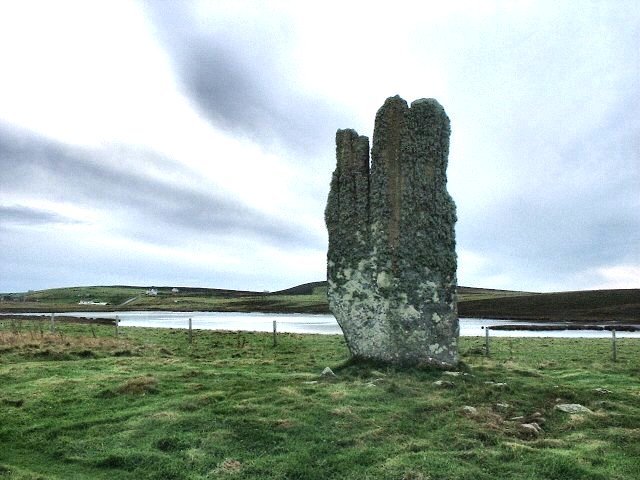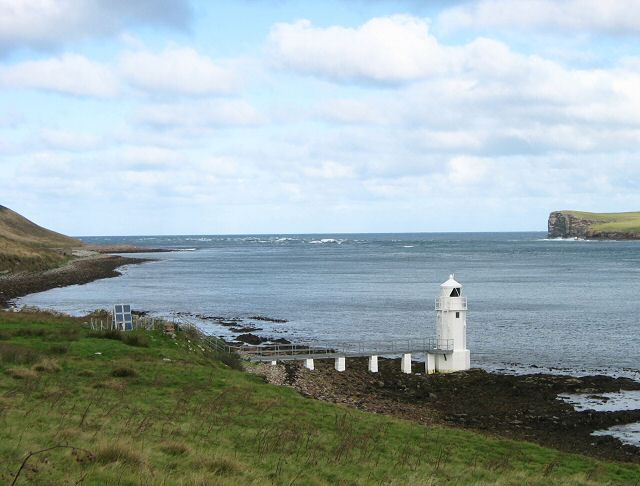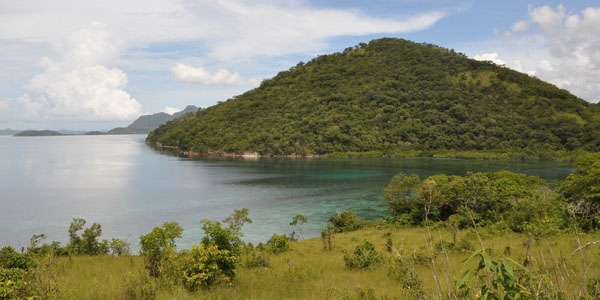Eday is one of the islands of Orkney, which are located to the north of the Scottish mainland. One of the North Isles, Eday is about 24 kilometres (15 mi) from the Orkney Mainland. With an area of 27 square kilometres (10 sq mi), it is the ninth largest island of the archipelago. The bedrock of the island is Old Red Sandstone, which is exposed along the sea-cliffs.
There are various well-preserved Neolithic tombs, as well as evidence of Bronze Age settlement and the remains of a Norse-era castle. During the period of Scottish rule the substantial property of Carrick House was developed at Calfsound, which became a burgh for a short period. During the British era many agricultural improvements were introduced, although there has been a substantial decline in the population since the mid-nineteenth century. In the twenty-first century the Eday Partnership has had success in promoting the island's economy. Local placenames reflect the diverse linguistic heritage and the landscapes of the island and its surrounding seas attract abundant wildlife.
History
Scottish rule
In 1468 Orkney became part of the Kingdom of Scotland and an influx of Scottish entrepreneurs helped to create a diverse and independent community that included farmers, fishermen and merchants that called themselves comunitatis Orcadie and who proved themselves increasingly able to defend their rights against their feudal overlords. Nonetheless, the actions of the aristocracy continue to provide much of the information known about affairs on Eday at the time. In 1561, during the Reformation, Edward Sinclair was granted the feu of Eday by Adam Bothwell, Bishop of Orkney. These were turbulent times—Sinclair's duties included to defend the reforming Bishop "against whatsoever invaders" — and later that year he was one of the ringleaders of an anti-Catholic riot in Kirkwall.
His son William took over the running of the Eday estate in due course, but it became burdened with debt. In 1601 when Edward was "an auld decrepit man ... aged 100 or thereby" William attempted to sell the family interest to George Sinclair the Earl of Caithness. The new proprietor sent half a dozen boatloads of "vagabondis, broken Highland men of Caithness" to Eday, much to the alarm of the notorious Earl Patrick of Orkney. Earl Patrick was able to use the poor relationship between the elderly father Edward and his son, (the former claiming William fired muskets at him and grabbed him by the neck like a dog) to take action. Acting, so he alleged, on behalf of Edward, Earl Patrick evicted William, took the Eday the rents for himself and profited from the extraction of building stone from Towback quarry.
John Stewart, Earl of Carrick, the brother of Earl Patrick, was granted Eday in 1632 and he constructed Carrick House at Calfsound shortly thereafter. He used peat to manufacture salt from salt pans at both Carrick and on the Calf of Eday. The product was described as "quite fine" in the 17th century when it was undertaken on a substantial scale although of "indifferent quality"[36] in the early 19th century when it was being conducted as a cottage industry. Peat extraction was also an important industry in the past as Sanday and North Ronaldsay obtained most of their fuel from Eday and this material was also exported to whisky distilleries on mainland Scotland.
Stewart's ambitions for Calfsound were considerable. Described as the "town and port" of Carrick it became a burgh (the only other one in Orkney being Kirkwall) with the right to appoint baillies and hold markets but it was never likely to flourish in such a location.
Natural history
In the early 19th century Patrick Neill wrote of the local flora that "Eda is a mossy island; a great part of it consisting of barren marshy heaths. Juncus uliginosus here covers whole acres; and the pretty little plant Radiola millegran, or all-seed, is everywhere strewed." Over 120 species of wild plants have been recorded on the island including bog myrtle found nowhere else in Orkney.
In the mid-17th century, Eday was described as being "absolutely full of moorland birds" and today there are red-throated divers on Mill Loch, Arctic skuas and bonxies on the moors and black guillemot offshore. Shore birds include meadow pipit, rock pipit and ringed plover. The woodland at Carrick House attracts a variety of migrants and otters can be seen around the coasts. There are colonies of harbour and grey seals on Muckle Green Holm, Little Green Holm, Faray and Holm of Faray, and white-beaked dolphin, minke whale and killer whale are occasional visitors to the area. A ranger provideds guided walks throughout the year.















